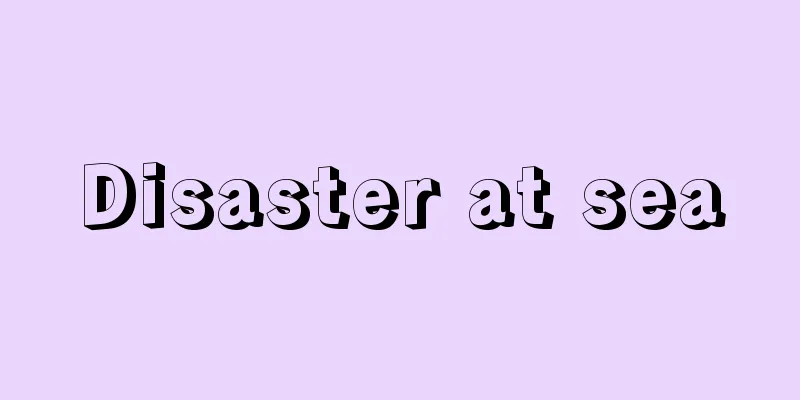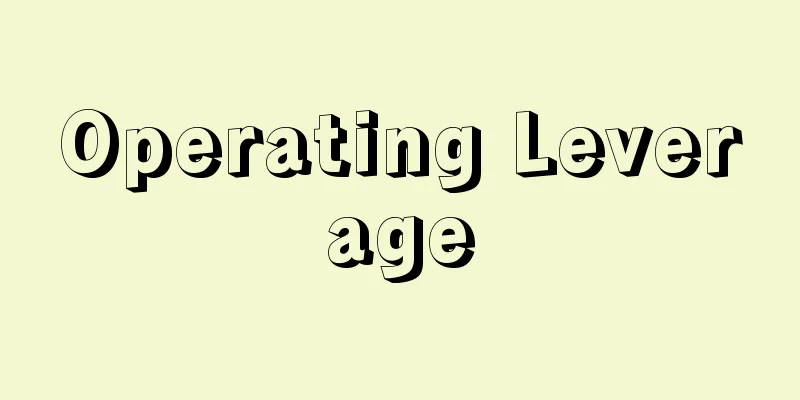Disaster at sea

|
It is a general term for disasters at sea, but academically it refers to dangers or accidents that ships, cargo, and people on board (sailors, passengers, and visitors) suffer individually or simultaneously. Maritime accidents are classified into collision, grounding, distress, missing, sinking, flooding, capsizing, loss, fire, engine damage, and injury. Collision includes contact, and grounding includes stranding, being driven aground, being stranded, touching the bottom, etc. The Marine Accident Inquiry Act (Act No. 135 of 1947) is as follows: "In connection with operations" refers to all cases where a ship is used for its intended purpose, such as navigation, anchorage, docking, etc., and facilities refer to quays, breakwaters, navigational markers, etc. "Safety is impaired" refers to a situation in which a ship is in danger of causing a marine accident due to violation of maritime traffic laws (Act on Prevention of Collisions at Sea, Act No. 62 of June 1, 1977; Maritime Traffic Safety Act, Act No. 115 of July 3, 1972, and Port Regulations Act, Act No. 174 of July 15, 1948) and the Seafarers Act (Act No. 100 of September 1, 1947), etc., or for other reasons. "Operation is hindered" means when the ship's hull lists due to improper cargo stowage or cargo shifting, and the voyage is interrupted (such as by calling at a port) to transfer the cargo, when the voyage is interrupted due to grounding without causing damage to the hull, when the ship becomes unable to operate due to a lack of fuel, fresh water, etc., or when a condition occurs that prevents the ship from operating normally due to a violation of regulations. In the following cases, the captain must report (maritime accident report) to the Regional Transport Bureau office, the designated city or town mayor, or a consulate as provided for in the Seamen's Act, and the captain or shipowner may request certification of the reported facts by presenting the logbook. (1) When a vessel suffers a collision, grounding, sinking, fire, engine damage, or other maritime accident. (2) When engaged in the salvage of life or ship. (3) When, while underway, he learns of distress of another vessel, except when he learns of it by wireless telegraphy. (4) When a person on board dies or goes missing. (5) When the planned route is changed. (6) When the vessel is detained or captured, or when any other serious accident occurs to the vessel. [Shintani Fumio] Maritime Accident CasesOn April 10, 1912, the luxury passenger liner Titanic, which was on its maiden voyage across the Atlantic Ocean from Southampton, England, bound for New York, struck an iceberg off the coast of Newfoundland at around 11:40 pm on April 14 and sank about two and a half hours later. Of the 2,224 passengers and crew on board, 1,513 died, sending shockwaves around the world. The ship was a state-of-the-art vessel with a gross tonnage of approximately 46,329, a main engine output of 55,000 horsepower, a maximum speed of 22 knots, and a double-bottom hull that made it known as an "unsinkable ship." The causes of the accident were said to be a failure to obtain information about the iceberg, a lack of lifeboats, and inexperienced handling. To learn from this accident and to improve maritime disaster prevention measures, the following year in 1913, major shipping nations attended an international conference in London and adopted the International Convention for the Safety of Life at Sea (commonly known as the SOLAS Convention or the Safety of Life at Sea Convention). It was subsequently amended in 1929, 1948, and 1960. Japan also reorganized its relevant laws and regulations based on this international convention, and in 1933 promulgated the Ship Safety Act (Act No. 11 of 1933). Since then, it has made repeated amendments in consideration of international conventions. On August 10, 1998, a portion of the starboard shell of the Titanic (a first-class cabin, weighing about 20 tons) was salvaged for the first time in 86 years from the ocean floor (about 4,000 meters deep) about 600 kilometers southeast of Newfoundland, about 16 kilometers from the hull of the ship. In September 1954 (Showa 29), Typhoon No. 15 struck, and the Toya Maru, a ferry between Hakodate and Hakodate Port, which had taken refuge outside the breakwater, was tossed about by strong winds and rough waves with a maximum instantaneous wind speed of 58 meters per second, and the anchor was dragged and the ship ran aground on shallow waters off the coast of Nanaehama, where it capsized, killing 1,155 of the 1,314 passengers and crew (the Toya Maru incident). In addition, the cargo ships Hidaka Maru, Tokachi Maru, Kitami Maru, and No. 1 Seikan Maru, which had also taken refuge in the same area, also sank, with 275 crew members sharing the fate of their ships, making this a rare disaster in the history of world maritime disasters. In March 1967, the large tanker Torrey Canyon (118,285 deadweight tons, Liberian flag) ran aground on a reef in the Seven Stone Islands southwest of the UK, causing the hull to break (the Torrey Canyon incident). Of the 118,000 tons of crude oil it was carrying, 58,000 tons spilled, with oil up to 40 centimeters thick washing ashore along the UK coastline for 160 kilometers, and polluting a wide area as far as the west coast of France. On March 28, a Royal Navy plane dropped bombs on the wreck of the Torrey Canyon, setting it ablaze, in order to dispose of the crude oil. This caused fire hazards, seawater pollution, and fishing disasters worth about 10 billion yen, and attracted worldwide attention as a maritime disaster involving a huge tanker that caused a wide range of pollution. For this reason, the Intergovernmental Maritime Consultative Organization (currently the International Maritime Organization (IMO)) in London adopted the 1974 SOLAS Amendment in November 1974, which has since been amended several times. Japan has also revised its relevant laws and regulations based on this. On January 5, 1969, the ore carrier Boribaa Maru (33,768 tons, loaded with iron ore, 33 crew members) was sailing to Japan when it suddenly broke near hold No. 2 and sank at approximately 33 degrees north latitude, 144 degrees 36 minutes east longitude (approximately 500 km southeast of Nojimasaki Lighthouse on the Boso Peninsula), killing 32 crew members (Boribaa Maru Incident). The following year, a similar ship, the California Maru (34,002 gross tons, 29 crew members), was sailing to Japan, loaded with Kaiser pellets in Los Angeles, when suddenly, at around 10 p.m. on February 9, a breach occurred in the outer hull of the ship near ballast tank No. 1 on the port side, causing it to flood and sink at approximately 35 degrees 10 minutes north latitude, 143 degrees 55 minutes east longitude, killing the captain and four other crew members. Over the past dozen years, a series of accidents involving 12 large ships have occurred in the waters east of Japan (latitude 31-36 degrees north, longitude 143-160 degrees east, approximately 360-2000 km from Cape Nojima). These accidents occurred during a winter-type atmospheric pressure pattern with high pressure in the west and low pressure in the east, when strong winds from the west prevailed, and in this area, the Kuroshio Current, which moves northward, meanders greatly to the east, causing a large temperature difference between the water temperature of 17-20°C and the air temperature of 0-5°C, and the stability of the sea surface is extremely poor. Cold strong winds then blew in, generating larger waves than expected. In December 1980, while the Onomichi Maru was sailing at a speed of about 5 knots in waves 7 to 8 meters high, it was suddenly hit directly ahead of the bow by a huge wave 15 meters high, causing the ship to slam (the ship rides on the crest of the wave and the wave hits the bottom of the ship), and a large amount of seawater rushed in, causing the bow to break off. Japan conducted an investigation to clarify the abnormal waves in this area. Shortly before 1:37 p.m. on November 9, 1974, the dangerous goods tanker Yuyo Maru No. 10 (43,723 gross tons, fully loaded with LPG), proceeding north along the Nakanose Passage in the northern part of Tokyo Bay, collided with the Pacific Ares (10,874 gross tons, Liberian-registered), loaded with steel materials, near the north entrance of the same passage, and exploded. The bow of the Pa was crushed, and the fire from the Yuyo Maru engulfed it in flames, causing a major fire, killing 28 of the 29 crew members and burning one. Five crew members of the Yuyo Maru were killed and seven were burned, and the ship ran aground and continued to burn without effective firefighting. The wreckage of the ship was pulled out of the bay and sunk by gunfire, bombs, and torpedoes, but it took 19 days for the disaster to occur, showing the terribleness of a large tanker accident. Between the end of 1976 and the spring of 1977, about 15 tanker accidents occurred off the coast of the United States, leading to President Carter issuing a statement in March 1977 calling for stronger regulations on tankers. The following February, the International Conference on Tanker Safety and Pollution was held in London, with 62 countries, including Japan, participating and adopting a protocol to the 1974 SOLUS Convention. Furthermore, as many marine accidents were caused by crew negligence, the International Convention on Standards of Training, Certification and Watchkeeping for Seafarers (STCW Convention) was adopted in 1978 in order to improve the quality of seafarers around the world. Japan ratified this convention and revised the relevant laws and regulations in 1982 (Showa 57). On the night of March 16, 1978, the tanker Amoco Cajis (233,000 DWT, Liberian flag, 44 crew members) en route from the Persian Gulf to the UK ran aground off the coast of the port of Brest in France, breaking off its stern and spilling about 170,000 tons of crude oil, polluting 200 km of the northern coast of Brittany, and drifting ashore in an area of about 2,000 square kilometers in the English Channel from the west coast of the Cotentin Peninsula, 200 km from the point of running aground. On the 24th, the hull split in two and the stern sank, and 50,000 tons of remaining oil began to leak, and on the 29th, a French Navy helicopter dropped 12 small mines to blow up the wreckage. On July 10, 1980, the Derbyshire (91,654 gross tons, 294 meters long, British flag) arrived at Sept Isle, Canada, loaded with 157,466 tons of fine ore concentrate with a diameter of 2 mm or less, and departed for Kawasaki the same day. On August 8, the ship was sailing off the coast of Cape Town with 44 people on board, including crew members who had been resupplied and replaced by helicopter and their two wives, when on September 3, it received information about a tropical depression south of Mindanao. The depression became Typhoon Orchid on the 6th, and the ship was caught up in Orchid and at 9:30 a.m. (UT) on September 9, it sent a telegram to its owner stating, "The ship is experiencing rough weather and is in difficulty, but is scheduled to arrive in Kawasaki on September 14," and then disappeared without issuing a distress message. Starting in late May 1994, the research vessel Shinkai 6500 used sonar to survey the ocean floor covering 591 square kilometers, and on June 2nd, it found the wreckage, including the bow section bearing the ship's name, scattered at a depth of about 4,250 meters. The British Transport Secretary, with the cooperation of the European Commission and the United States, then conducted a first sonar survey in June 1996, and a map of the sea floor where the wreckage was scattered was created. A second sonar survey was conducted in March and April 1997, and 200 hours of close-up video footage was taken of the 69 wreckage pieces that were identified. Based on the results of the survey, it was estimated that a large wave that had washed up on the forward deck of the vessel had flowed in through the opening, and then the impact of the wave had destroyed the hatch cover, flooding the first hold, and it was confirmed that the vessel had sunk in the waters east of Okinawa (25°52′N, 133°32′E). On the night of December 20, 1987, the Philippine domestic ferry Doña Paz (2,215 gross tons, 1,493 passengers) and the Philippine tanker Victor (629 gross tons, 8,800 barrels of oil, 14 crew members) collided, caught fire, and sank in the Dabras Strait (between Marindoque and Mindoro islands), about 150 km south of Manila. The Manila Rescue Coordination Center announced that the Doña Paz had 47 crew members and 1,583 passengers (passenger list), but the only survivors on both ships were four passengers on the Doña Paz and two crew members on the Victor. At the time of the accident, it was said that there were about 3,000 people on board, with Christmas and the New Year approaching. The Doña Paz was used in Japan as the Himeyuri Maru for about 10 years, but at the time, its passenger capacity was 680. At 9:30 pm on March 23, 1989, the Exxon Valdez (214,859 deadweight tons) departed from the Valdez Terminal. At around 11:30 pm, the pilot disembarked, and the captain obtained permission to proceed into the waters due to the presence of drifting ice. At around 11:51 pm, while the third officer was maneuvering, the vessel ran aground on a reef at Bligh Island, and failed to free itself, spilling approximately 41,000 kiloliters of crude oil. The oil spill spread outside the bay, polluting more than 1,700 kilometers of coastline, causing approximately $4.5 billion in pollution damages, including the death of living organisms, and costing Exxon $2 billion in damages. At 7:15 pm on September 27, 1994, the passenger ferry ship Estonia (15,586 gross tons) departed from Tallinn, the capital of Estonia, bound for Stockholm, Sweden. About halfway along the voyage, the ship was sailing at full speed of about 14 knots in a southwesterly wind of about 18-20 meters per second, with waves coming towards the port bow. At about 1 am on the following day, the 28th, the impact of a big wave hit the bow visor (a type of door that closes the opening of the bow after automatic loads are guided in from the opening of the bow) and broke the hinge (a joint that does not move up and down or left and right but can rotate freely) and the fixing metal of the visor, pushing the visor forward and contacting the rampway, partially opening the rampway and allowing a large amount of seawater to flow into the car deck (the Estonia incident). As a result, the ship's hull listed more than 15 degrees to starboard, and at around 1:25 the list reached more than 40 degrees, causing the engines to stop, and the ship began to sink stern-first while drifting, and at around 1:34 the list reached more than 80 degrees, and at around 1:50 the ship disappeared from the surface of the northern Baltic Sea. At the time, there were 802 passengers and 186 crew members on board the ship, and only 137 people (13.9%) were rescued. In this case, (1) the visor abnormality was discovered late (the visor indicator light installed on the bridge did not indicate the visor abnormality), (2) the hull tilt reached 30 degrees too quickly, making it difficult to escape from the ship, (3) the life-saving equipment was useless, and (4) there was no radio station that could hear the distress signal, and human error, structural defects, and delayed rescue all contributed to the damage. The ship did not learn from the lessons learned from the sister ship, the Herald of Enterprise (7,960 gross tons, 80 crew members, 463 passengers), which capsized near the breakwater about 800 meters from the pier after leaving the port of Saybrook (Belgium) at around 7:50 p.m. on March 6, 1987, leaving the port of Saybrook (Belgium), leaving the pier, leaving 164 people dead and missing, and 100 injured. In the early hours of January 2, 1997, the Nakhodka (13,157 gross tons, Russian flag) was sailing from Shanghai to Tropavsk, Russia when suddenly, about 106 km northeast of the Oki Islands, the hull broke and the stern sank, spilling an estimated 6,200 kiloliters of heavy oil from the broken part, and the bow (2,800 kiloliters of remaining oil) washed ashore off the coast of Anto Cape in the Mikuni-cho district of Sakai City, Fukui Prefecture on the afternoon of the 7th (Nakhodka Heavy Oil Spill Accident). The spilled oil washed ashore in one prefecture and eight prefectures (from Shimane to Akita) along the Sea of Japan coast, and in the three months following the disaster, a total of about 270,000 volunteers were engaged in the task of recovering the oil. At approximately 10:05 a.m. on July 2, 1997, the Diamond Grace (147,012 gross tons) hit the bottom about six kilometers off the coast of Honmoku, Yokohama, spilling about 1,550 kiloliters of crude oil. By the following day, the oil had spread over an area of about five kilometers north to south and about 18 kilometers east to west, and approximately 330 ships were mobilized to deal with the spill. At around 9:00 pm on October 15, 1997, the tanker Olanpin Global (129,703 gross tons, Thai flag) and the tanker Epoikos (75,428 gross tons, Cyprus flag) collided in the strait 5 km south of Singapore, causing the Epoikos to spill about 25,000 tons of crude oil, part of its cargo. Thirty-eight ships, with the cooperation of Japan, the United States, Australia, and other countries, attempted to recover the oil. The oil polluted the territorial waters of Malaysia and Indonesia from nearby islands, and a week after the accident, a 33 km long oil strip was discovered in the southern Strait of Malacca. The amount of oil spilled was about four times that of the Nakhodka. In Japan, there were 7,703 maritime accidents in 1997, involving 8,881 vessels. By type, 1,480 (19.2%) were groundings, 1,824 (23.7%) were collisions, and 3,084 (40.0%) were shipwrecks, accounting for approximately 83% of the total. By type of vessel involved, the order was cargo ships at 3,458 (38.9%), fishing boats at 1,515 (17.2%), oil tankers at 1,094 (19.1%), tugboats at 845 (9.5%), and passenger ships at 792 (8.9%). A look at the number of incidents and vessels over the past five years shows a continuing downward trend ( ). [Shintani Fumio] Cause investigationWhen an accident occurs at sea, there is a marine accident inquiry (trial) system to determine the cause of the accident in order to prevent the recurrence of the same type of accident. In Japan, the Marine Accident Tribunal (two-tier system, High Marine Accident Tribunal1, Regional Marine Accident Tribunals7, and Marine Accident Tribunal Directorates1, Regional Marine Accident Tribunal Directorates7) determines the cause of the accident through a quasi-judicial trial, imposes disciplinary punishment on marine personnel (including those approved under the Ship's Officers and Small Vessel Operators Act) or pilots if the accident was caused by their intentional or negligent acts in the course of their duties, and issues recommendations to other people involved in the cause of the accident. The pre-trial procedures and execution of the decision are handled by the Directorate of the Directorates. The causes of marine accidents can be broadly divided into human factors (crew qualifications, ship-handling and equipment operation errors), ship factors (structural and equipment defects), and environmental factors (weather and sea conditions in the navigational area, etc.). In 1997, the Regional Marine Accident Tribunals carried out trials for 762 cases involving 1,055 ships, determining 29 causes of marine accidents and a total of 1,463 causes. Of these, the main causes were insufficient lookout (30.4%), non-compliance with navigational laws (12.2%), and inappropriate command and supervision of service (8.1%). In the 340 collision cases, the main causes were insufficient lookout (47.4%), failure to comply with navigational regulations (19.3%), and failure to sound signals (9.8%). Of the 436 vessels with insufficient lookouts, 316 (72.5%) did not see the other vessel until just before the collision, while the rest were vessels that did not recognize the risk of collision or assumed that the other vessel would avoid them. In the 168 grounding cases, the main causes were dozing off (29.6%), failure to confirm vessel position (21.4%), and insufficient hydrographic survey (12.6%). The 61 vessels where dozing off was the cause ran aground between late night and early morning, and 48 of these vessels were using automatic steering. In recent years, marine accidents occurring in conjunction with the mass transportation of energy and passengers have become extremely horrific, and the impact of accidents such as oil spills on the marine environment has been attracting particular attention. For this reason, it has been suggested that each country and coastal countries must cooperate to investigate the causes of marine accidents that occur in their own country or in the surrounding waters, and prevent their recurrence. In 1968, 1979, and 1989, the IMO passed resolutions on the investigation of marine accidents (information exchange and investigative cooperation), and on November 27, 1997, at the 20th IMO General Assembly, a resolution was passed on the "Code for the Investigation of Marine Accidents and Incidents at Sea" for the purpose of international cooperation in marine accident investigations, and each country is currently considering how to implement the code in order to coordinate with its domestic laws. The code is: [Shintani Fumio] Prevention of Maritime AccidentsPreventing accidents at sea and safe navigation are two sides of the same coin, and preventing accidents at sea is essential for a ship to achieve its intended purpose. Compliance with maritime traffic laws and related laws and regulations, and improving ship navigation techniques, contribute greatly to preventing accidents at sea. The Seamen's Act imposes the following obligations on the captain to prevent accidents at sea and ensure safe navigation by making full use of his or her best skills and command authority (to give orders to those on board the ship necessary to perform their duties) (Captain's Obligations). [1] Obligation to remain on board. No person shall leave the ship while cargo and passengers are on board unless unavoidable or after delegating command of the ship to another person in his place. [2] Command on deck When navigating in dangerous waters, the captain is in charge of command on deck himself. [3] Measures to be taken when the ship is in danger When the captain of a ship is in imminent danger, he shall take all necessary measures to save lives, the ship, and its cargo. [4] Inspection before departure When a ship departs from a port, the following items are inspected to ensure that there are no impediments to the voyage (ensuring seaworthiness): (1) The hull, engine and drainage systems, steering equipment, anchor lifting equipment, life-saving equipment, radio equipment, and other equipment must be in good condition. (2) The stowage of the cargo is not in a condition that would impair the stability of the ship. (3) The safety of the vessel is maintained based on the draft conditions. (4) Fuel, food, fresh water, medicines, ship's stores and other items necessary for the voyage are on board. (5) Hydrographic charts and other publications necessary for navigation must be available. (6) Weather reports, marine reports and other information necessary for navigation have been collected, and based on that information there is no disruption to the navigation. (7) The ship has the necessary number of crew members to carry out the voyage and that the crew members are in good health. (8) All other necessary preparations have been made to ensure the smooth completion of the voyage. [5] Watertightness: To prevent water from entering the ship, (2) Close portholes that are inaccessible during navigation watertight and, if necessary, lock them. (3) Close any other openings and supervise the crew to keep the ship watertight. (4) For ocean-going passenger ships, watertight doors and their indicators, watertight valves in compartments, and operating valves for damage control cross connecting pipes shall be inspected weekly, and the power-operated watertight doors of the main transverse bulkheads shall be inspected daily for operation. [6] Emergency array and drills The captain of a passenger ship or a ship (including a fishing boat) operating in coastal or deep-sea areas must prepare an emergency array that specifies the operations to be performed by crew members in the event of a maritime disaster or other emergency (closing watertight doors and draining water, operating fire doors and other fire-prevention equipment and other fire-fighting operations, carrying food and navigational equipment into lifeboats and drilling lifeboats and rescue boats, operating life-saving equipment such as lifeline launchers, calling for and guiding passengers), as well as their positions and signals, etc., and post the list in an appropriate place such as the crew's room. Captains must also regularly conduct drills on fire prevention, rescue boats, waterproofing, and emergency steering. [7] Patrol system The captain shall establish a patrol system in passenger ships to prevent fires and other accidents, and in roll-on/roll-off passenger ships to monitor the movement of cargo in roll-on/roll-off cargo areas or vehicle areas and the entry of persons into said areas. Chapter 5 of the SOLUS Convention, entitled "Safety of Navigation," prescribes weather reports, distress reports, and the "Ship Reporting System" under Regulation 8-1. The system is established by the Contracting Parties to contribute to the safety of life at sea, the safety and efficiency of navigation, and the protection of the marine environment, and is adopted in accordance with the guidelines and standards that IMO will develop under Regulation 8-1. The system allows ships, specific types of ships, or ships carrying specific cargoes to communicate with each other and receive information assistance for their navigation under international guidelines, standards, and rules, and the masters of such ships provide all information requested by the competent authorities and cooperate with each other to ensure the safe navigation of ships. IMO recognized the need for a company-wide approach between the ship and the shore organization of the shipping company to prevent accidents at sea, and in April 1994, it stipulated the International Safety Management (ISM) Code in Chapter 9 (Safety Management of Ships) of the SOLUS Convention, and shipping companies are to establish and comply with the requirements of the Code. The Code has been applied to passenger ships, tankers and bulk carriers of 500 gross tons or more engaged in international voyages since July 1, 1998, and to other ships since July 1, 2002. In addition, in order to improve the quality of seafarers, the 1995 STCW Convention has been revised to be up-to-date and is scheduled to come into effect on February 1, 2002. In addition, the SOLUS Convention provides detailed provisions in its annexes on ship structure (compartment and stability, and machinery and electrical equipment), fire protection and fire extinguishing equipment, life-saving equipment, radio communication, and the transportation of cargo and dangerous goods. [Shintani Fumio] Measures to be taken in the event of a marine accident The captain, (2) Move your ship to an area where there is no danger to other vessels, and if the ship sinks, place a marker or other sign indicating the ship's location. (3) In the event of collision, unless the first vessel is in imminent danger, each vessel shall take all necessary measures to save life and the other vessel, and shall announce the names, owners, ports of registry, departure ports, and destination ports of each vessel. Each vessel shall also appoint an appraiser to inspect the damage on both sides together with the appraiser of the other vessel and prepare a report. (4) When we learn of another ship or aircraft in distress, we will do all necessary measures to save human life. There are obligations such as: The IMO adopted the 1979 International Convention on Maritime Search and Rescue (SAR Treaty) and the IMO Rescue Search and Rescue Handbook, which stipulates in detail the SAR agencies (structure, operational plans, forces-air, maritime and coastal, supplies and life-saving equipment, communications and procedures, the position reporting system) and SAR procedures (sea search and rescue, communications, search area setting, search technology, search implementation, survivor rescue, emergency assistance, etc.), so these should be referred to when requesting search and rescue. Signals for rescue after being lost are stipulated in the Maritime Collision Prevention Act, etc., but radio equipment and other equipment related to GMDSS (Global System for Disasters and Safety at Sea), a communication system that uses satellites to contribute to marine rescue and navigation safety, was fully implemented from February 1, 1999. Furthermore, when leaving the ship, an EPIRB (an emergency position indicator radio sign device for use of polar orbit satellites), which is an emergency position indicator for use of polar orbit satellites, is carried on the life raft. [Anitani Fumio] [Reference items] | | | | | | | | | | | | | | |©Shogakukan "> Trends in the number of marine accidents and ships [Table] Source: Shogakukan Encyclopedia Nipponica About Encyclopedia Nipponica Information | Legend |
|
海における災害の総称であるが、学問的には船舶、貨物および在船者(船員、旅客および訪船者)が、個々にもしくは同時に受ける危険または事故をいう。海難は衝突、乗揚げ、遭難、行方不明、沈没、浸水、転覆、滅失、火災、機関損傷および傷害などに分類される。衝突は接触を、乗揚げは座礁、擱座(かくざ)、座州(ざす)および底触などをそれぞれ包有している。 海難審判法(昭和22年法律135号)は、 「運用に関連して」とは、航行、停泊、入渠(にゅうきょ)など船舶をその目的に沿って使用しているすべての場合をいい、施設とは岸壁、防波堤または航路標識などをいう。「安全が阻害された」とは、海上交通法規(海上衝突予防法=昭和52年6月1日法律第62号、海上交通安全法=昭和47年7月3日法律第115号および港則法=昭和23年7月15日法律第174号)および船員法(昭和22年9月1日法律第100号)等の違反その他の理由により、船舶が海難を引き起こすおそれのある状態を生じたことをいう。「運航が阻害された」とは、貨物の積付け不良または荷崩れなどのため船体が傾斜し、航海を中断(寄港など)して貨物を積み換える場合、船体の損傷を伴わない乗揚げで航海を中断した場合、燃料や清水などの積込み不足のため運航不能に陥った場合、法規違反のため船舶の運航を停止または正常な運航を妨げる状態を生じた場合をいう。 船長は、次の場合には、船員法に定めるところにより地方運輸局の事務所もしくは指定市町村長または領事館に報告(海難報告)し、船長または船舶所有者は報告した当該事実について、航海日誌を呈示のうえ証明を求めることができる。 (1)船舶の衝突、乗揚げ、沈没、火災、機関の損傷その他の海難が発生したとき。 (2)人命または船舶の救助に従事したとき。 (3)無線電信によって知ったときを除いて、航行中他の船舶の遭難を知ったとき。 (4)船内にある者が死亡し、または行方不明となったとき。 (5)予定の航路を変更したとき。 (6)船舶が抑留され、または捕獲されたときその他船舶に関し著しい事故があったとき。 [新谷文雄] 海難事例1912年4月10日イギリスのサザンプトンから、大西洋横断の処女航海でニューヨークに向かった豪華旅客船タイタニック号が、4月14日午後11時40分ころ、ニューファンドランド沖で氷山に衝突し、約2時間半後に沈没した。乗客・乗員2224人のうち1513人が死亡し、世界に大きな衝撃を与えた。同船は約4万6329総トン、主機関出力5万5000馬力、最高速力22ノット、船体は二重底構造の「不沈船」とよばれた最新鋭船であった。事故の原因は、氷山情報入手の不手際、救命艇の不足と取扱いの未熟さなどにあるとされた。この事故の教訓を海難防止対策に生かすため、翌1913年ロンドンで主要海運国が参加して国際会議を開き、「海上における人命の安全のための国際条約」(通称海上人命安全条約またはソーラス条約)が採択され、その後1929年、1948年および1960年にそれぞれ改正された。日本も当該国際条約に基づいて関係法令を整理し、1933年に船舶安全法(昭和8年法律11号)を公布した。以後、国際条約を考慮して改正を重ねてきた。1998年8月10日、ニューファンドランド島の南東約600キロメートルの海底(水深約4000メートル)からタイタニック号の船体より約16キロメートル離れていた同号の右舷(うげん)外板の一部(一等船客室、重さ約20トン)が、86年振りに引揚げられた。 1954年(昭和29)9月台風15号が来襲して、函館(はこだて)港防波堤外に避泊していた青函(せいかん)連絡船洞爺(とうや)丸が、瞬間最大風速58メートルの暴風と波浪に翻弄(ほんろう)され、錨(いかり)が引きずられて七重浜(ななえはま)沖の浅瀬に乗揚げて転覆し、旅客と乗組員1314人のうち1155人が死亡した(洞爺丸事件)。このほか同じ海域に避泊していた青函連絡貨物船日高丸、十勝(とかち)丸、北見丸および第一青函丸も沈没し、乗組員275人が船と運命をともにし、世界海難史上希有(けう)の惨事となった。 1967年3月大型タンカー、トリー・キャニオン号(11万8285重量トン、リベリア船籍)が、イギリス南西のセブン・ストン群島の岩礁に乗揚げて船体が折れた(トリー・キャニオン号事件)。積荷の11万8000トンの原油のうち5万8000トンが流出し、最大の厚さ約40センチメートルの原油がイギリスの海岸線約160キロメートルに漂着し、また遠くフランス西海岸まで広く汚染した。3月28日ト号の残骸(ざんがい)の原油を処理するため、イギリス海軍機が爆弾を投下して炎上させた。このため火災の危険、海水汚濁、漁業災害など約100億円の損害を生じ、広範囲に多様な公害を発生させた巨大タンカーの海難として、世界の注目を集めた。このため1974年11月ロンドンの政府間海事協議機関(現、国際海事機関IMO)で、「1974年ソーラスの改正条約」が採択され、その後数次にわたる改正が行われた。これに基づいて日本でも関係法令を改正してきた。 1969年1月5日、鉱石運搬船ぼりばあ丸(3万3768トン、鉄鉱石を満載、乗組員33人)が日本に向かって航行中、北緯33度、東経144度36分付近(房総半島野島埼灯台の南東約500キロメートル)で突然第2番倉付近が折損して沈没し、乗組員32人が死亡した(ぼりばあ丸事件)。翌年同種のかりふぉるにあ丸(3万4002総トン、乗組員29人)がロサンゼルスでカイザーペレットを満載して、日本に向かって航行中、2月9日午後10時ごろ突然左舷1番バラストタンク付近の船側外板に破口を生じ、北緯35度10分、東経143度55分付近で浸水して沈没し、船長ほか4人の乗組員が死亡した。 過去十数年間に、日本の東方海域(北緯31~36度、東経143~160度、野島崎から約360~2000キロメートル)で12隻の大型船の事故が相次いで発生した。これらの事故は、冬型の西高東低の気圧配置で、西寄りの強風が卓越する時期に発生し、またこの海域では、北上した黒潮が東に大きく蛇行し、水温17~20℃、気温0~5℃と両者の温度差が大きく、海面の安定度がきわめて悪いところへ冷たい強風が吹き込んで予想を超える大波が生じたためとされている。1980年12月尾道丸(おのみちまる)が、波高7~8メートルのなかを約5ノットの速力で航行中、突然正船首方向から高さ15メートルの大波が襲い、スラミング(船が波の頂きに乗り、船底を波がたたく)と同時に多量の海水が打ち込み、船首部が折損したことが判明した。日本は、この海域における異常波浪を解明するために調査を行った。 1974年11月9日午後1時37分少し前、東京湾北部の中ノ瀬航路を北上中の危険物タンク船第拾雄洋丸(4万3723総トン、LPG満載)が、同航路の北口付近で、鋼材を満載したパシフィック・アレス(1万0874総トン、リベリア船籍)と衝突して爆発炎上した。パ号は船首部が圧壊され、雄洋丸からの火災に包まれて大火災を起こし、乗組員29人中28人が死亡し、1人がやけどを負った。雄洋丸は乗組員5人が死亡し、7人がやけどを負い、有効な消火がなされないまま乗揚げて燃え続け、同船の残骸は、湾外に引き出されて砲・爆・雷撃を加えられて撃沈したが、事故発生から19日間を要する大惨事となり、大型タンカー事故の凄絶(せいぜつ)さを実見させられた。 1976年末から1977年春にかけて、アメリカ沿岸で約15件のタンカーの海難が発生し、1977年3月カーター大統領がタンカーの規制強化を内容とした声明を発表した。翌年2月ロンドンで「タンカーの安全および汚染に関する国際会議」が開かれ、日本を含めて62か国が参加し、1974年のソーラス条約に関する議定書を採択した。また、海難は船員の過失によるものが多く、世界の船員の資質向上を図るため、1978年「船員の訓練、資格証明および当直維持の基準に関する国際条約」(STCW条約)が採択され、日本もこれを批准し、1982年(昭和57)に関係法令を改正した。 1978年3月16日夜、ペルシア湾からイギリスに向かって航行中のタンカー、アモコ・カジス(23万3000DWT=載貨重量トン、リベリア船籍、乗組員44人)が、フランスのブレスト港沖で座礁して船尾が折れ、約17万トンの原油が流失してブルターニュの北岸200キロメートルを汚染し、座礁地点から200キロメートル離れたコタンタン半島西岸から英仏海峡内の約2000平方キロメートルの海域に漂着した。24日船体が真二つに裂けて船尾が沈み、残油5万トンが流失し始め、29日フランス海軍のヘリコプターが小型機雷12発を投下して残骸を爆破した。 1980年7月10日カナダのセプト・アイスル港に到着したダービシャー号(9万1654総トン、長さ294メートル、イギリス籍)は、直径2ミリメートル以下の微粉精鉱を15万7466トン積載し、同日川崎港に向けて出港した。同号は、8月8日ケープタウン沖でヘリコプターによる補給および交代した乗組員とその妻2人を含む44人を乗船させて航行中、9月3日ミンダナオ島の南方で熱帯低気圧の情報を入手した。同低気圧は6日に台風オーチドになり、同号はオーチドに巻き込まれて9月9日午前9時30分(世界時)船主に向けて、「本船は荒天に遭遇して難航中であるが、9月14日川崎着の予定」と打電し、その後遭難通信を発することなく消息を絶った。1994年5月末から海洋調査船「しんかい6500」がソナーにより591平方キロメートルにわたる海底を調査し、6月2日、水深約4250メートルに散乱していた船名のついた船首部分を含む残骸を確認した。その後、イギリスの運輸大臣は欧州委員会およびアメリカの協力を得て、1996年6月に第1段階のソナーによる調査を実施し、残骸が散乱している海底付近の地図が作成された。1997年3月から4月にかけて第2段階のソナーによる調査が実施され、確認できた69の残骸について200時間に及ぶ接近したビデオ映像が撮影された。その調査に基づいて検討された結果、同号の前部甲板に打ち上げた大波が開口部から流入し、その後ハッチカバーが波浪の衝撃により破壊されて第1船倉に浸水したと推定され、同号は沖縄の東方海域(北緯25度52分、東経133度32分)に沈没したことが確認された。 1987年12月20日夜、マニラ南方約150キロメートルのダブラス海峡(マリンドケ島とミンドロ島間)で、フィリピン内航フェリー、ドニャパス(2215総トン、旅客定員1493人)と同国籍のタンカー、ビクトル(629総トン、石油8800バレル積載、乗組員14人)が衝突し、炎上して沈没した。マニラ救助調整センターは、ドニャパスには乗組員47人と旅客1583人(乗客名簿)が乗船していたと発表したが、両船の生存者は、ドニャパスの旅客4人とビクトルの乗組員2人に過ぎなかった。事故当時は、クリスマスと年末を控えて3000人ぐらい乗船していたのではないかといわれた。ドニャパスは、日本で約10年間ひめゆり丸として使用されたが、当時、旅客定員は680人であった。 1989年3月23日午後9時30分にエクソン・バルデイズ(21万4859重量トン)はバルディスターミナルを出帆した。午後11時30分ごろ水先人が下船し、船長は流氷があるため許可を得て入航航路を進行した。同11時51分ごろ三等航海士が操船中、本船はブライ島の暗礁に乗揚げ、自力離礁に失敗して約4万1000キロリットルの原油を流出した。流出油は湾外にまで広がって1700キロメートル以上の海岸線を汚染し、生物の死等の汚染損害は約45億ドルに達し、エクソン社は20億ドルの被害を受けた。 1994年9月27日午後7時15分にエストニアの首都タリンからスウェーデンのストックホルムに向けて出港した旅客フェリー船エストニア号(1万5586総トン)は、ほぼ航程なかばに達したころ、約18~20メートルの南西風が吹くなかを左舷船首に向かい波を受けて、約14ノットの全速力で航行していた。翌28日午前1時ごろ船首バイザー(船首開口部から自動平等を誘導積載した後、開口部を閉じる扉の一種)を襲った大波の衝撃により、バイザーのヒンジ(上下左右に動かないが回転自在の接合部)部分と固定金具が破損し、バイザーが前方に押し出されてランプウェイに接触し、ランプウェイが部分的に開放されて大量の海水がカーデッキに流れ込んだ(エストニア号事件)。このため船体が右舷に15度以上傾斜し、同1時25分ごろには傾斜が40度以上に達して機関が停止し、漂流しながら船尾から沈み始め、同1時34分ごろには傾斜が80度以上に達し、1時50分ごろ同号はバルト海の北部の海面から姿を消した。当時、同号には旅客802人および乗組員186人が乗船しており、わずかに137人(13.9%)が救助されたにすぎなかった。 本件では(1)バイザーの異常の発見が遅れ(船橋に設置されていたバイザー表示灯がバイザーの異常を表示しなかった)、(2)船体の傾斜が30度に達するまでの時間が早過ぎて、船内からの脱出が困難となり、(3)救命設備が役に立たず、(4)遭難信号を聴取していた無線局がなく、人為的ミス、構造上の欠陥および救助の遅れなどが被害を拡大させた。同号は、1987年3月6日午後7時50分ごろセーブルック港(ベルギー)を出て桟橋から約800メートル離れた防波堤付近で横転し、死者および行方不明者164人ならびに負傷者100人を出した同型船のヘラルド・オブ・エンタプライズ(7960総トン、乗組員80人、旅客463人)の教訓を生かしていなかった。 1997年1月2日未明、上海からロシアのトロパブロスクへ向けて航行中のナホトカ号(1万3157総トン、ロシア国籍)が、隠岐諸島の北東約106キロメートルの海上で突然船体が折損して船尾部が沈没し、折損部から重油約6200キロリットル(推定)が流出し、船首部(2800キロリットルの残油)は7日午後福井県坂井(さかい)市三国町地区の安島(あんとう)岬沖に漂着した(ナホトカ号重油流出事故)。流出油は日本海側の1府8県(島根県から秋田県)に漂着し、災害発生後約3か月間に、延べ約27万人のボランティアが油の回収作業に従事した。 1997年7月2日午前10時05分ごろ、ダイヤモンドグレース(14万7012総トン)が横浜市本牧(ほんもく)沖約6キロメートルで底触して原油約1550キロリットルを流出し、翌3日には油が南北約5キロメートル、東西約18キロメートルに拡散し、約330隻の船舶が動員されてその処理にあたった。 1997年10月15日午後9時ごろタンカー、オランピン・グローバル(12万9703総トン、タイ船籍)とタンカー、エポイコス(7万5428総トン、キプロス船籍)が、シンガポールの南5キロメートルの海峡内で衝突し、エポイコスから積荷の一部約2万5000トンの原油が流失した。38隻の船舶が日本、アメリカおよびオーストラリアなどの協力を得て油の回収にあたった。油は付近の島からマレーシアおよびインドネシアの領海を汚染し、事故から1週間後にマラッカ海峡南部に約33キロメートルにわたる油の帯が発見された。油の流出量はナホトカ号の約4倍に達した。 わが国において、1997年に発生した海難は7703件、関係船舶数が8881隻で、これを種類別に見ると、乗揚げの1480件(19.2%)、衝突の1824件(23.7%)および遭難の3084件(40.0%)が目だち、これらが全体の約83%を占めている。関係船舶の種類別をみると、貨物船の3458隻(38.9%)、漁船の1515隻(17.2%)、油送船の1094隻(19.1%)、引き船の845隻(9.5%)および旅客船の792隻(8.9%)の順となっている。過去5年間における件数および隻数の推移をみると減少傾向が続いている()。 [新谷文雄] 原因究明海難が発生すると、同種の海難の再発を防止するために海難の原因を究明する海難審判(裁判)制度がある。わが国における同制度は、海難審判庁(二審制、高等海難審判庁1、地方海難審判庁7および海難審判理事所1、地方海難審判理事所7)が準司法手続きによる審判により海難の原因を明らかにし、海難が海技従事者(船舶職員及び小型船舶操縦者法により承認を受けた者を含む)または水先人の職務上の故意または過失によって発生したものであるときは懲戒を課し、その他海難の原因に関係がある者に対し勧告を行う。審判前の手続きおよび裁決の執行は、理事所の理事官が担当する。 海難を引き起こす原因は、人的要因(乗組員の資質、操船および機器の操作ミス)、船舶要因(構造および機器の欠陥)および環境要因(航行水域における気象、海象等)に大別される。1997年(平成9)には地方海難審判庁が762件、1055隻の船舶を対象に審判を行い、海難原因として29項目、原因数として1463が裁決された。このうち、主要な原因は、見張り不十分(30.4%)、航法不遵守(12.2%)ならびに服務に関する指揮および監督の不適切(8.1%)である。 340件の衝突事件においては、見張り不十分(47.4%)、航法不遵守(19.3%)および信号不吹鳴(9.8%)等が主因とされている。見張り不十分な436隻の船舶のうち、衝突直前まで相手船を認めていなかった船舶が316隻(72.5%)もあり、その他は、衝突のおそれを確認しない船舶および相手船が避けると臆断(おくだん)した船舶である。168件の乗揚げ事件においては、居眠り(29.6%)、船位不確認(21.4%)および水路調査不十分(12.6%)が主因とされている。居眠りが原因とされた61隻の船舶は、深夜から早朝にかけて乗揚げており、そのうち48隻の船舶が自動操舵装置を使用していた。 近年、エネルギーおよび旅客の大量輸送に伴って発生する海難は凄惨(せいさん)を極め、とくに流出油などの事故が海洋環境に与える影響が注目されてきた。このため、各国が自国およびその周辺海域で発生した海難について、沿岸関係国などが協力して原因を究明してその再発を防止する必要性が提唱された。IMOにおいて1968年、1979年および1989年に海難の調査(情報交換、調査協力)に関する決議がなされたが、1997年11月27日IMO第20回総会において、海難調査に関する国際協力を目的とした「海難および海上インシデントの調査のためのコード」が決議され、同コードの履行について各国が国内法との調整を図るため検討している。 同コードは、 [新谷文雄] 海難防止海難防止と安全運航とは表裏一体の関係にあり、船舶がその使用目的を達成するには海難防止が不可欠である。海上交通法規および関係法令の遵守と船舶の運航技術の向上が、海難防止に大きく寄与する。船員法は、船長が最高技術と指揮命令権(船内にあるものに対し、自己の職務を行うのに必要な命令をする)を駆使することにより、海難を防止して安全運航を担保するため、次の義務を船長に課している(船長の義務)。 〔1〕在船義務 やむをえない場合または船長にかわって船舶を指揮する者に委任したあとでなければ、貨物および旅客を積載中は、船舶を去ってはならない。 〔2〕甲板上の指揮 危険が発生しやすい水域を航行するときは、船長が自ら甲板上にあって指揮する。 〔3〕船舶に危険がある場合の措置 船長は自船に急迫した危険があるときは、人命、船舶および積荷の救助に必要な手段を尽くす。 〔4〕発航前の検査 船舶が発港するとき、航海に支障がないよう次の事項について検査する(堪航(たんこう)性の確保)。 (1)船体、機関および排水設備、操舵(そうだ)設備、揚錨(ようびょう)設備、救命設備、無線設備その他が整備されていること。 (2)積載物の積付けが船舶の安定性を損なう状況にないこと。 (3)喫水の状況から判断して、船舶の安全性が保たれていること。 (4)燃料、食料、清水、医薬品、船用品その他の航海に必要な物品が積み込まれていること。 (5)水路図誌その他の航海に必要な図誌が整備されていること。 (6)気象通報、水路通報その他の航海に必要な情報が収集されており、それらの情報から判断して航海に支障がないこと。 (7)航海に必要な員数の乗組員が乗り組み、かつ、それらの乗組員の健康状態が良好であること。 (8)そのほか、航海を支障なく成就するため、必要な準備が整っていること。 〔5〕水密の保持 船舶の浸水を防止するため、 (2)航行中に近寄りがたい舷窓(げんそう)を水密に閉じ、必要あれば施錠する。 (3)そのほかの開口部を閉鎖し、海員を監督して船舶を水密に保持する。 (4)外航旅客船は、水密戸および同表示器などの装置、区画室の水密弁ならびに損傷制御用クロス連結管の操作用弁を毎週点検し、主横置隔壁の動力式水密戸を毎日作動点検する。 〔6〕非常配置表および操練 旅客船ならびに近海区域または遠洋区域を航行する船舶(漁船も含む)の船長は、海難等の非常の場合における海員の作業(水密保持のための水密戸等の閉鎖および排水作業、防火戸等の防火設備の操作その他の消火作業、食料および航海用具等の救命艇等への搬入ならびに救命艇等および救助艇の操練、救命索発射器等の救命設備の操作、旅客の招集および誘導)配置および信号等を非常配置表に定めて船員室などの適当な場所に掲示し、防火、救助艇、防水および非常操舵の各操練を定期的に実施する。 〔7〕巡視制度 船長は、旅客船においては火災などを予防するため、さらにロールオン・ロールオフ(フェリーなどがトラックなどをそのまま乗降させられることをいう)旅客船においてはロールオン・ロールオフ貨物区域もしくは車両区域における貨物の移動または同区域への立入者を監視するため、それぞれ巡視制度を設ける。 ソーラス条約第5章は、「航行の安全」と題して気象通報、遭難通報および第8-1規則の「船舶通報制度」等を定めている。同制度は、海上における人命の安全、航行の安全および能率ならびに海洋環境の保護に寄与するために締約国によって樹立され、かつIMOが第8-1規則に基づいて作成する指針および規準に従って採択される。同制度は、船舶、特定の種類の船舶または特定の貨物を運送する船舶が、国際的な指針、規準および規則により、相互に交信して、情報による船舶の航行の支援を受け、当該船舶の船長は、権限ある当局から要求されるすべての情報を提供し、相互に協力して船舶の安全航行を図る。 IMOは、海難の防止を図るためには、船社の陸上組織と船舶が一体となって全社的に取組む必要があることを認め、1994年4月にソーラス条約第9章(船舶の安全管理)に国際安全管理(ISM)コードを規定し、船社は、同コードの要請をみたす安全管理システムを定めて遵守することになった。同コードは、国際航海に従事する旅客船、500総トン以上のタンカーおよびバルカー(ばら積み運送船)等に1998年7月1日から適用され、その他の船舶には2002年7月1日から適用される。また、船員の資質の向上を図るために、1995年STCW条約を改正してその最新化を図り、2002年2月1日に発効することになっている。そのほかソーラス条約は、その付属書において船体の構造(区画および復原性ならびに機関および電気設備)、防火および消火設備、救命設備、無線通信、貨物および危険物の運送等について詳細に定めている。 [新谷文雄] 海難発生時の措置船長は、 (2)他の船舶の交通の危険がない海域に自船を移動させ、沈没したときはその船位を示す標識等を設置する。 (3)船舶が衝突したときは、自船に急迫した危険があるときを除き、互いに人命および船舶の救助に必要な手段を尽くし、かつ船名、所有者、船籍港、発航港および到達港を告げる。また鑑定人を依頼し、相手船の鑑定人とともに双方の損害を検査させて報告書を作成する。 (4)他の船舶または航空機の遭難を知ったときは、人命の救助に必要な手段を尽くす。 などの義務がある。 IMOは、1979年の海上捜索救助に関する国際条約(SAR条約)およびIMO救助捜索救助便覧を採択して、同条約(便覧)にはSAR機関(構成、業務計画、部隊‐航空、海上および沿岸、補給物品および救命装備品、通信の実施および手続、船位通報制度)およびSAR手続(海上における捜索救助、通信、捜索区域の設定、捜索技術、捜索の実施、生存者の救助、緊急援助等)等について詳細に定めているので、捜索救助を要請するときにはこれらを参照する必要がある。 遭難して救助を求める信号は、海上衝突予防法等に定められているが、衛星等を利用して海難救助および航行安全に資する通信システムであるGMDSS(海上における遭難および安全に関する世界的な制度)に関する無線設備等の設置が、1999年2月1日から完全に実施された。また退船するときは、遭難者の位置を特定することを目的とした救命設備でもあるEPIRB(極軌道衛星利用非常用位置指示無線標識装置)を救命筏(いかだ)に携行する。 [新谷文雄] [参照項目] | | | | | | | | | | | | | | |©Shogakukan"> 海難の件数・隻数の推移〔表〕 出典 小学館 日本大百科全書(ニッポニカ)日本大百科全書(ニッポニカ)について 情報 | 凡例 |
Recommend
Palace of Fontainebleau - Fontainebleau Palace
Palais de Fontainebleau : A palace in Fontaineblea...
Eisai - Eisai
A monk from the Kamakura period. He is considered...
Brackets
〘 noun 〙 (from the sound of "karakoro") ...
Opunile - Opunile
...Because Iomante is an important event that is ...
Kawamutsu - Kawamutsu
A freshwater fish belonging to the order Cyprinif...
Permissible Concentration - Kyoyou no Udo
This is an occupational hygiene index concentrati...
Hokota [town] - Hokota
A former town in Kashima County, eastern Ibaraki P...
Wheeler (English name) Robert Eric Mortimer Wheeler
1890‐1976 British archaeologist. Born in Glasgow, ...
Atractocerus niger (English spelling) Atractocerusniger
…The antennae are short, and the hind wings are f...
Isaac - yitschāq (Hebrew)
One of the patriarchs of Israel. According to the...
Fishing - Fishing
Generally speaking, fishing can be broadly divide...
Cen Chun xuan (English spelling)
1861‐1933 Chinese politician. Born in Xilin, Guang...
Genital organs
The genitals are the organs responsible for the r...
Film Experiment Center
… [Mussolini's film policy] Italian cinema ce...
Magnolia denudata (English name)
…[Kunihiko Ueda]. … *Some of the terminology that...







![Fuchu [town] - Fuchu](/upload/images/67ccb6342dad4.webp)

